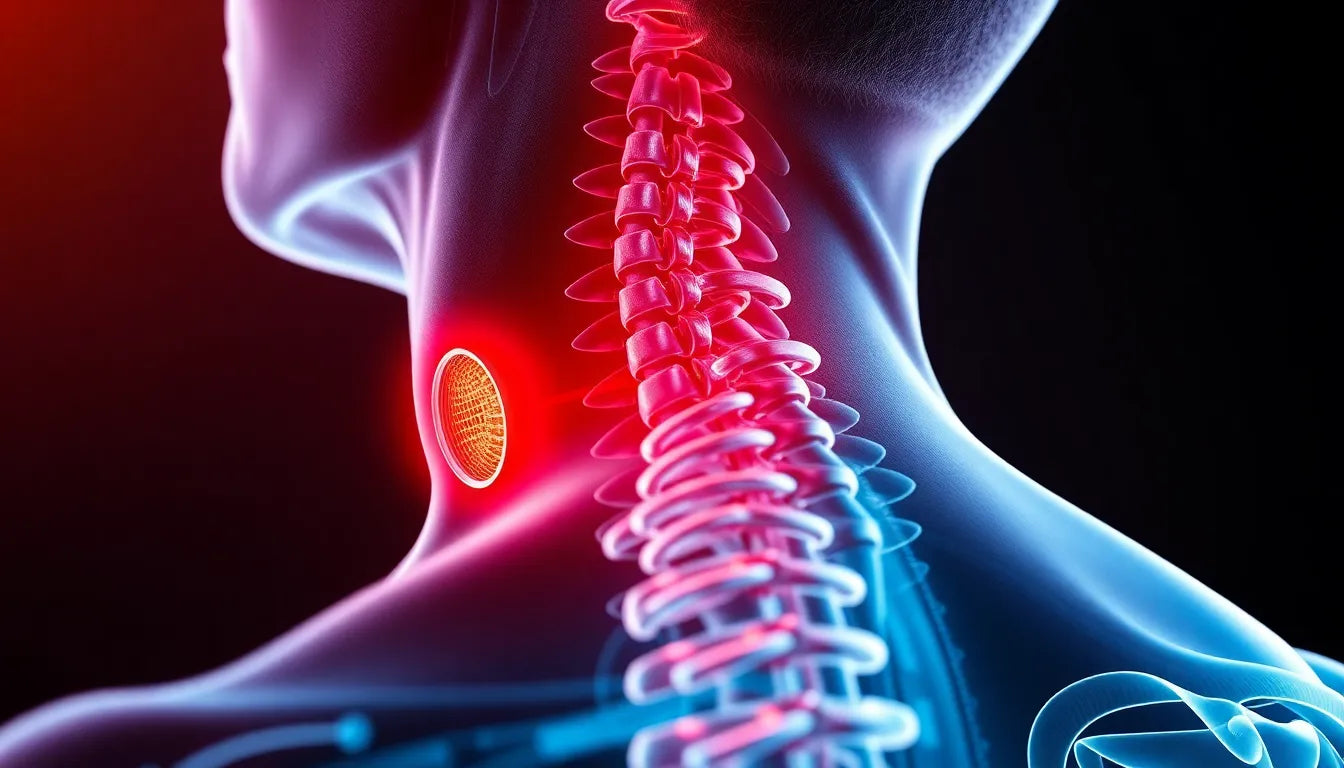The intricate structure of the neck is a marvel of anatomy, playing a crucial role in supporting the head and facilitating movement. At the core of this structure are the cervical discs, which act as cushions between the vertebrae, absorbing shock and allowing flexibility. However, when one of these discs becomes herniated, it can lead to a cascade of discomfort, including headaches that originate from the neck, known as cervicogenic headaches. Understanding the connection between a herniated disc in the neck and headaches is vital for addressing these symptoms and improving overall well-being.
Understanding the link between neck issues and headaches
A herniated disc in the neck occurs when the soft inner gel of the disc pushes through a tear in the tougher outer layer. This can irritate nearby nerves, causing pain that radiates to other areas, including the head. Cervicogenic headaches are a result of this nerve irritation and are often felt at the base of the skull, radiating towards the forehead or temples. These headaches can significantly impact daily life, making it essential to address the underlying neck issues to alleviate the pain.
The prevalence and impact of neck-related headaches
Neck pain and headaches are surprisingly common, affecting a significant portion of the population. Studies suggest that up to 70% of people will experience neck pain at some point in their lives, with a substantial number also reporting associated headaches. This condition can be debilitating, affecting productivity, sleep quality, and overall quality of life. Take, for example, the story of Sarah, a busy professional who found her work and personal life disrupted by persistent headaches stemming from a herniated disc. Her journey to finding relief underscores the challenges faced by many individuals dealing with this condition.
Addressing headaches caused by a herniated disc in the neck is not just about managing pain—it's about reclaiming one's life. By understanding the anatomy of the neck and the mechanisms behind these headaches, individuals can take proactive steps towards effective treatment and prevention. In the following sections, we will delve deeper into the causes, symptoms, and treatment options available for managing this condition, helping you find the relief you need.
Understanding herniated discs in the neck
A herniated disc in the cervical spine, commonly known as the neck, occurs when the soft, gel-like center of a disc pushes through a tear in its tougher exterior. This condition is often the result of wear and tear over time, known as disc degeneration, or can occur due to sudden injury or strain. The herniation can press on nearby nerves, leading to a variety of symptoms that extend beyond localized neck pain.
Common symptoms associated with cervical herniated discs include persistent neck pain, headaches, and discomfort that radiates down the arms. These headaches, particularly cervicogenic headaches, are distinct from migraines or tension headaches as they originate from the neck and are often accompanied by neck stiffness or reduced range of motion. Understanding these symptoms is crucial for distinguishing cervicogenic headaches from other types.
Diagnosis and initial steps
Early diagnosis is key to managing headaches caused by a herniated disc in the neck. Healthcare professionals typically begin with a thorough physical examination, assessing the range of motion and identifying any pain points. They may also perform specific tests to determine the source of the headache and neck pain.
Imaging studies such as MRI or CT scans are often employed to provide a detailed view of the cervical spine, helping to confirm the presence of a herniated disc and assess its impact on surrounding nerves. These diagnostic tools are essential in forming an accurate diagnosis and guiding the appropriate treatment plan.
Treatment options for cervical herniated discs
Once diagnosed, there are several treatment avenues for managing symptoms associated with a herniated disc in the neck. Nonsurgical treatments are typically the first line of defense. These include rest and activity modification, which help reduce strain on the neck. Medications such as nonsteroidal anti-inflammatory drugs (NSAIDs) and muscle relaxants can alleviate pain and inflammation.
Physical therapy plays a vital role in treatment, focusing on exercises that improve neck strength and flexibility. A physical therapist can guide patients through targeted exercises designed to relieve pressure on the nerves and reduce headache frequency and intensity.
For more severe cases where conservative treatments do not provide sufficient relief, advanced options may be considered. Nerve injections can offer significant pain relief by targeting the specific nerves affected by the herniated disc. In rare cases, surgical intervention may be necessary to remove or repair the herniated disc, especially if there is significant nerve compression or persistent pain that impairs daily function.
Understanding the range of treatment options available is crucial for individuals experiencing headaches due to a herniated disc in the neck. By working closely with healthcare professionals, patients can develop a personalized treatment plan that addresses their specific symptoms and needs.
Lifestyle modifications for relief from headaches caused by a herniated disc in the neck
Finding relief from headaches caused by a herniated disc in the neck often requires a combination of medical treatment and lifestyle modifications. One of the most effective ways to manage symptoms is by incorporating ergonomic aids into daily life. Ergonomic tools, such as adjustable chairs, desks, and supportive pillows, can significantly reduce strain on the neck, helping to prevent and alleviate headaches.
Maintaining good posture is essential in managing neck-related headaches. Whether at work or home, ensure that your workstation is set up to encourage a neutral spine position. Keep your computer monitor at eye level, use a chair with proper lumbar support, and avoid cradling the phone between your ear and shoulder. These small adjustments can make a substantial difference in reducing neck tension and preventing headaches.
In addition to ergonomic adjustments, regular exercises and stretches are crucial for alleviating neck tension. Incorporating simple neck stretches and strengthening exercises into your routine can improve flexibility and reduce the frequency of headaches. Gentle activities, such as yoga or Pilates, can also promote overall neck health and help in managing pain.
Conclusion: A holistic approach to managing headaches caused by a herniated disc in the neck
Addressing headaches caused by a herniated disc in the neck requires a comprehensive approach that combines medical treatments with lifestyle changes. By integrating ergonomic aids, maintaining good posture, and engaging in regular exercise, individuals can significantly improve their quality of life. It's important to consult with healthcare professionals to create a personalized management plan that addresses specific needs and symptoms.
Ultimately, taking a proactive approach to managing neck-related headaches can lead to long-term relief and a more comfortable daily life. By understanding the importance of neck health and implementing these strategies, individuals can reclaim control over their well-being.
Frequently Asked Questions
What are the common signs of a herniated disc in the neck?
Common signs of a herniated disc in the neck include persistent neck pain, headaches, and discomfort that can radiate to the shoulders and arms. These headaches, known as cervicogenic headaches, often start at the base of the skull and may be accompanied by neck stiffness and reduced range of motion.
How can I differentiate between a cervicogenic headache and a migraine?
Cervicogenic headaches typically originate from neck issues and are often accompanied by neck pain or stiffness. They usually start at the back of the head and may radiate to the forehead or temples. In contrast, migraines are often associated with nausea, visual disturbances, and sensitivity to light and sound, and they may not involve neck pain.
Are there any home remedies for managing headaches caused by a herniated disc?
Yes, several home remedies can help manage headaches caused by a herniated disc. Applying heat therapy, such as a warm compress, can relax tense muscles. Gentle neck stretches and exercises can also alleviate tension. Ensuring proper posture and using ergonomic aids at home and work can further reduce strain on the neck.
When should I consider surgery for a herniated disc in the neck?
Surgery for a herniated disc in the neck is generally considered when conservative treatments, such as medication and physical therapy, do not provide sufficient relief, and symptoms persist or worsen. If there is significant nerve compression leading to weakness or loss of function, surgical intervention may be necessary.
Can ergonomic aids really make a difference in managing neck-related headaches?
Yes, ergonomic aids can significantly impact managing neck-related headaches. By reducing strain on the neck and promoting proper posture, ergonomic tools can help alleviate tension and prevent the occurrence of headaches. Investing in ergonomic chairs, desks, and supportive pillows can improve overall neck health and quality of life.
Sources
- WebMD. "Cervicogenic Headache: Symptoms, Causes, and Treatments."
- Spine-Health. "Cervical Herniated Disc Symptoms and Treatment Options."
- Mayo Clinic. "Herniated Disk: Symptoms and Causes."
- Cleveland Clinic. "Cervicogenic Headache: Diagnosis and Treatment."
- Dignity Health. "Herniated Disc: Symptoms and Treatments."


















